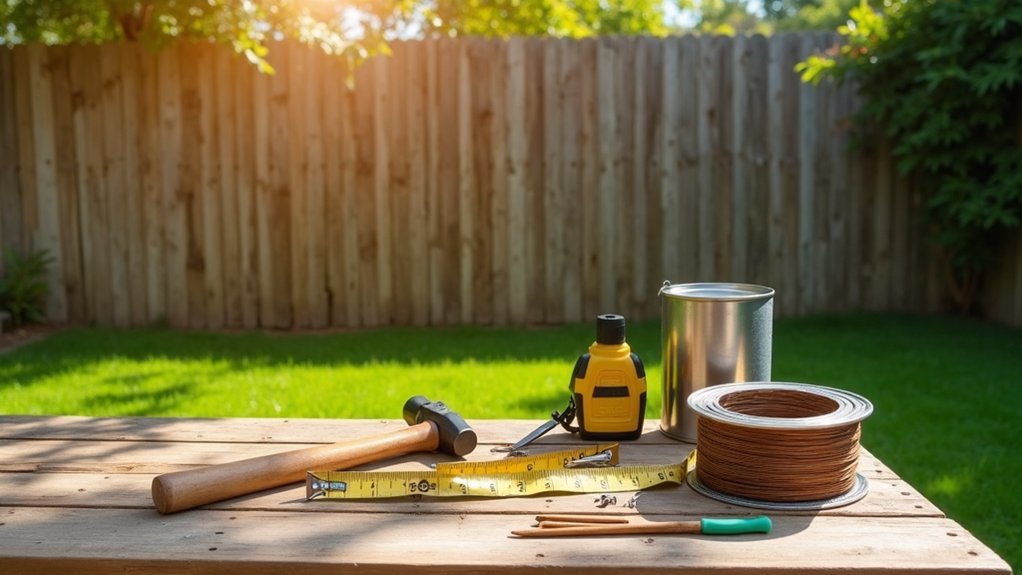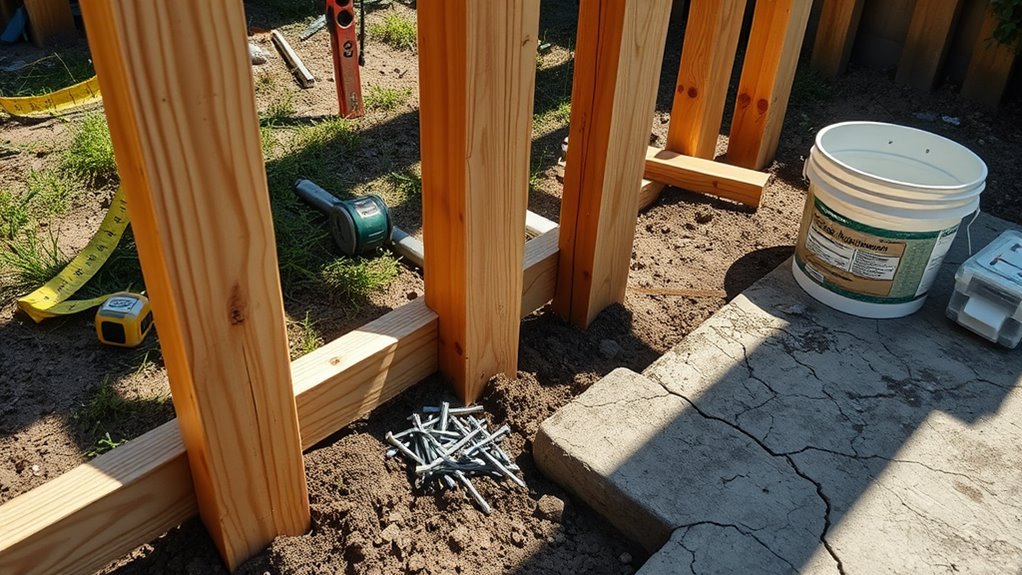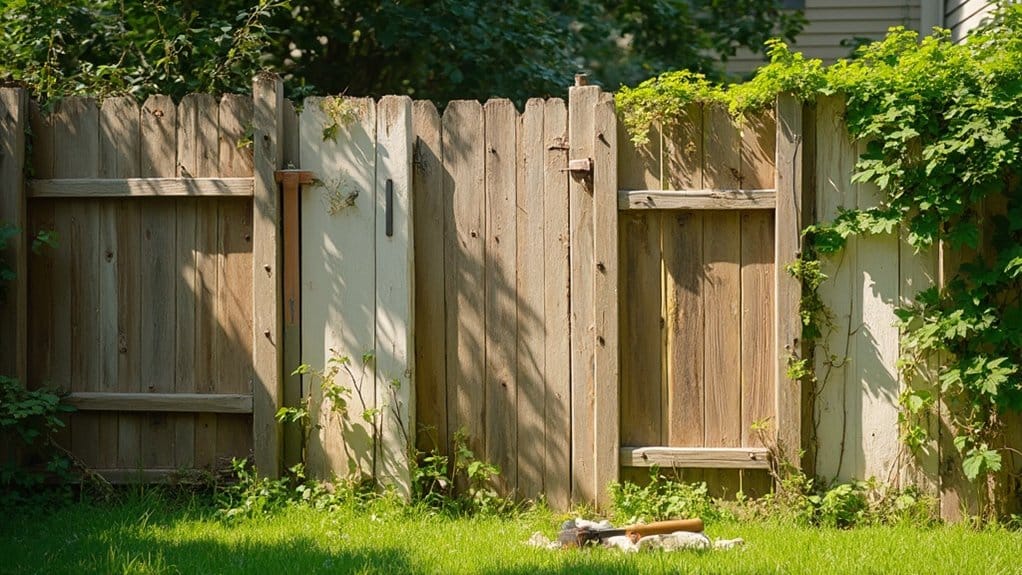To save money and time on DIY fence repairs, start with a thorough inspection to assess the damage. Use durable materials that complement your home’s style for lasting results. Learn essential repair techniques, such as how to replace rotted posts and damaged boards. Consider whether repairing or replacing is more economical based on the damage’s extent. Budget carefully, and team up with neighbors to share costs. You’ll discover more useful tips for successful repairs as you go.
Key Takeaways
- Start with a thorough visual inspection to spot damages before you begin repairs. This saves both time and materials.
- Use essential tools like a reciprocating saw and drill to make repairs quicker and easier.
- Only replace the damaged panels or posts instead of the whole fence to keep costs down and focus your efforts.
- Team up with neighbors to share repair costs and tools, making the process more affordable and efficient.
- Take photos and notes of your repairs for future reference, so you can assess any issues more quickly next time.
Assessing the Damage: Key Inspection Tips
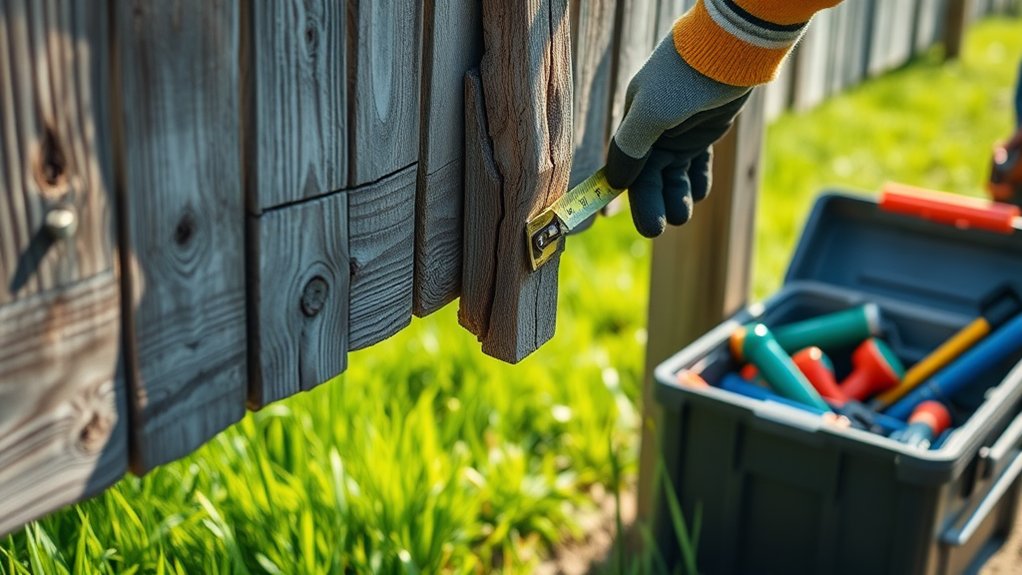
When you notice issues with your fence, it’s important to assess the damage carefully. Start with a visual check for broken panels, rust, or wood rot, particularly in wooden fences exposed to moisture. For metal fences, look for bent or broken sections and ensure gates open smoothly. Test the stability of each post by shaking it and apply pressure to the panels to identify any weaknesses. Also, check that the foundations are solid. Flooding can undermine post foundations, so be vigilant about any signs of shifting or collapse. Regular inspections and proactive maintenance can help prevent minor issues from escalating into major repairs. Take photos and notes to track what needs repairing. This proactive inspection will help keep your fence safe and durable.
Choosing the Right Materials for Your Fence
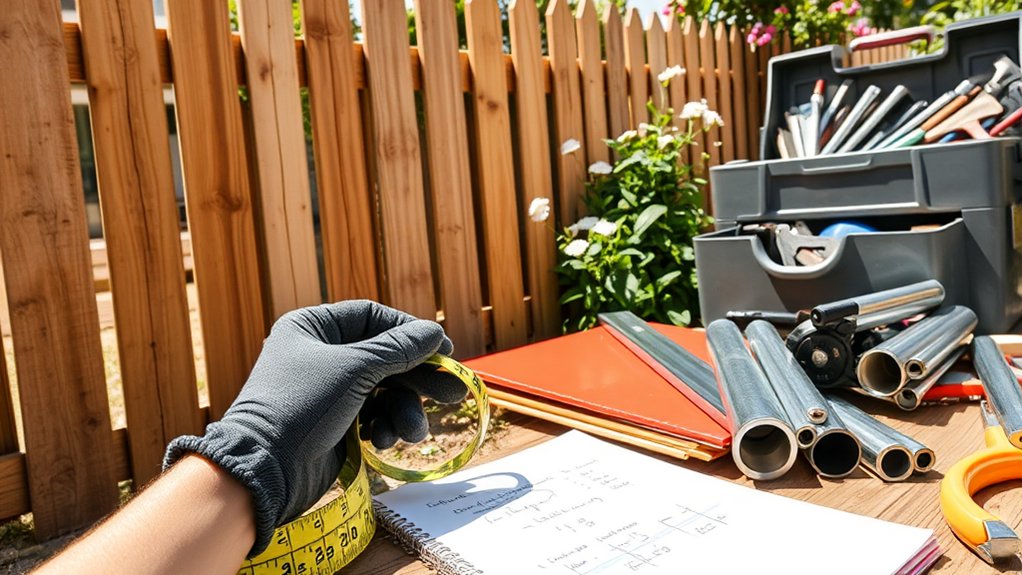
After assessing your fence damage, the next step is selecting the right materials for repair or replacement. Consider both durability and appearance. Here’s a quick comparison of common fence materials:
| Fence Type | Durability | Appearance |
|---|---|---|
| Wooden Fences | Moderate (with upkeep) | Natural charm |
| Vinyl Fences | High (low maintenance) | Modern look |
| Metal Fences | Very High | Industrial style |
Each material has its strengths. Wooden fences bring warmth, while vinyl and metal offer durability. Vinyl fencing is known for its aesthetic versatility, making it a great choice for various home styles. Repairing is economical if damage is limited to a specific area, so choose based on your needs and budget for an effective repair or replacement!
Essential DIY Repair Techniques for Homeowners
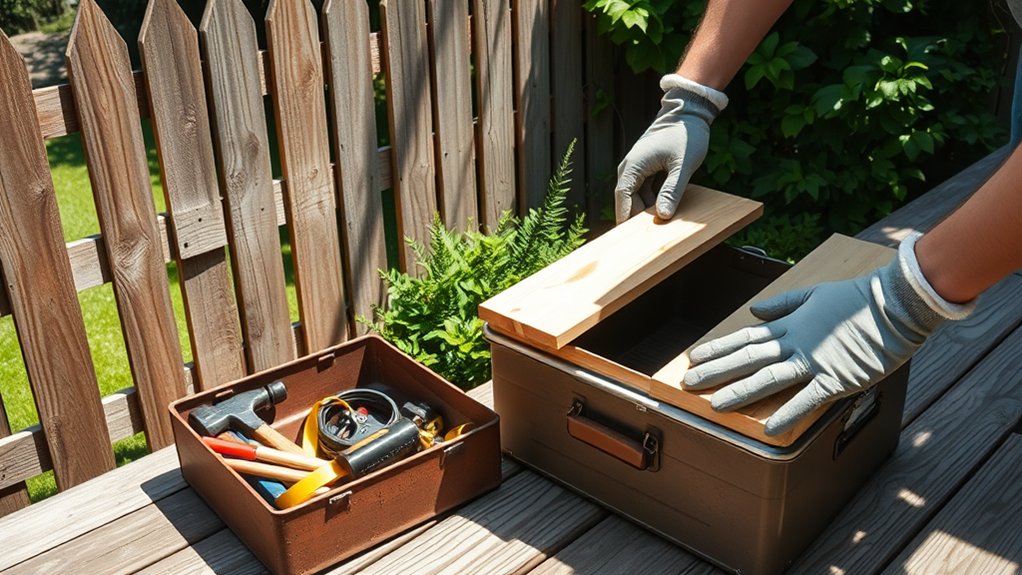
DIY fence repairs can be straightforward with the right approach. First, assess the damage and prioritize repairs. Equip yourself with essential tools like a reciprocating saw and drill. For rotted wood posts, replace them using 2×4 bracing and secure new posts with concrete. When fixing panels, swap out damaged boards and fill cracks with outdoor wood filler. Additionally, replace damaged slats in vinyl fences by removing caps and loosening screws for an efficient repair process. Always ensure you have safety precautions in place to protect yourself during repairs.
Regular maintenance is key—check for leaning posts and tighten loose fittings to avoid bigger problems. Always select materials suited to your climate, and keep a record of repairs for future reference. With these tips, you can maintain your fence easily and save money.
Making the Decision: Repair vs. Replace
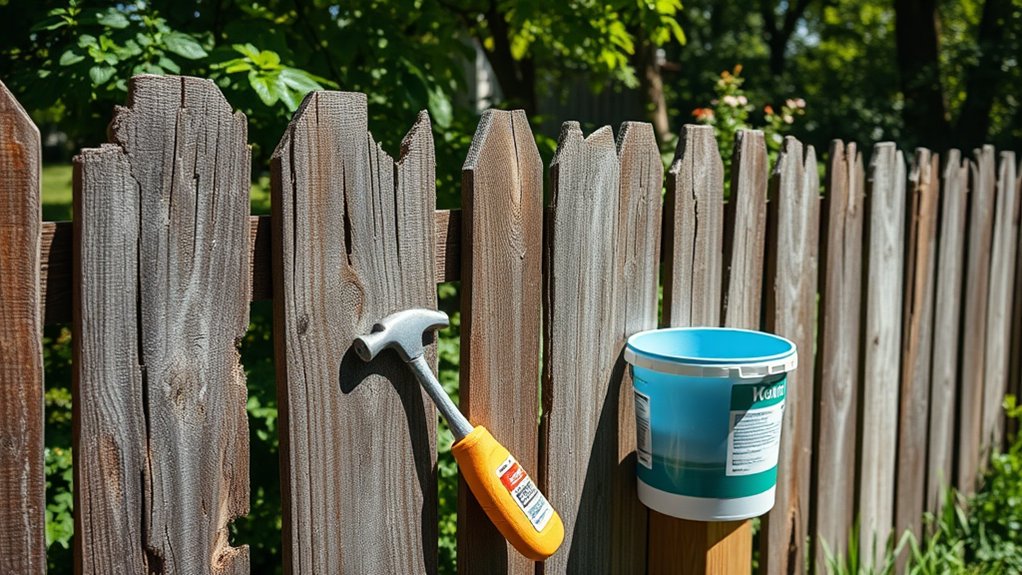
Deciding between repairing or replacing your fence can be tough, especially if you’re not sure how bad the damage is.
Start by checking the condition of your fence. If over 20-25% is damaged, replacing it might save you money in the long run.
Repair costs usually range from $250 to $750, but keep in mind that repeated repairs can add up and might cost more than a new fence.
Consider the type of materials as they differ in price and longevity.
Also, think about how the fence looks and its impact on your property value.
Weighing immediate repair costs against the long-term benefits of replacement is essential to find the best solution.
Budgeting and Timing Your Fence Repairs
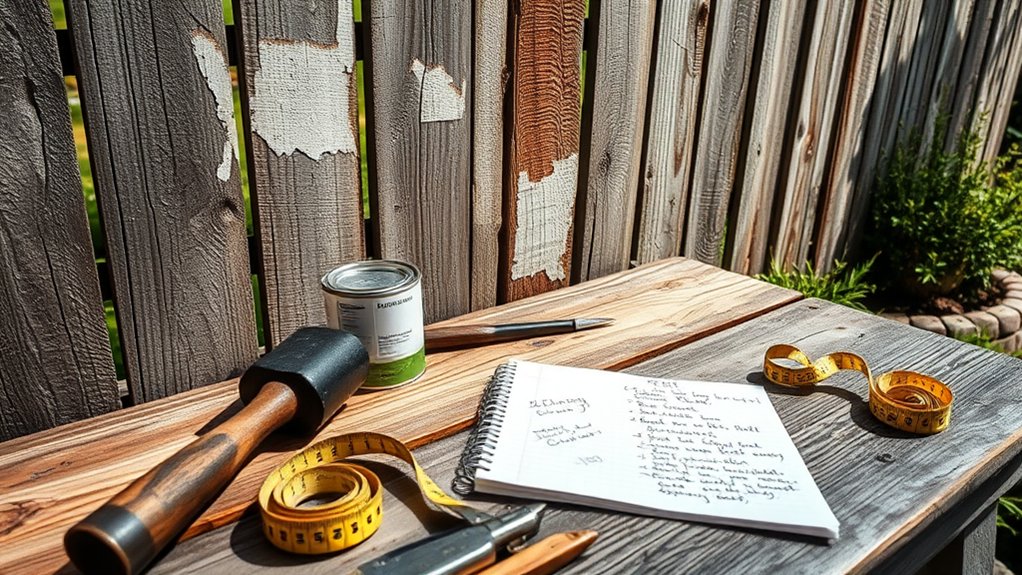
Budgeting for fence repairs requires careful planning to avoid overspending. Start by assessing the damage before purchasing any materials.
Here are some key steps:
- Make a list of all the damage.
- Get multiple quotes if hiring a professional.
- Accurately estimate the materials you’ll need.
- Set aside some extra money for unexpected costs.
- Consider any tools needed if you plan to do it yourself.
If costs start to add up, explore financing options.
Also, look for seasonal discounts; contractors often lower their rates in late fall or winter. By planning ahead and timing your repairs right, you can save both time and money.
Collaborating With Neighbors for Cost-Effective Solutions
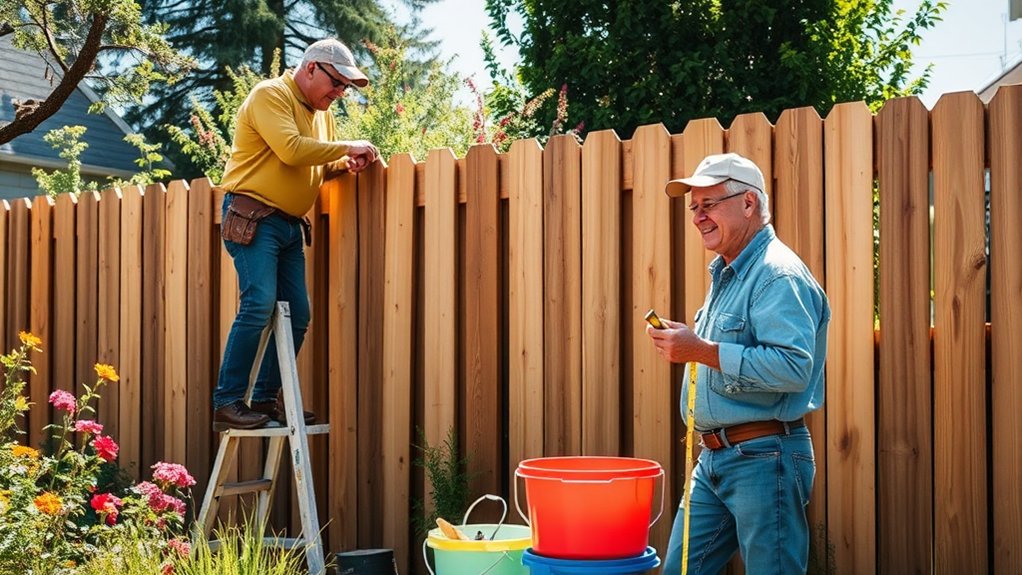
Working with your neighbor on fence repairs can save both time and money.
By splitting repair costs and coordinating inspection times, you can address issues more effectively.
For example, if a section of the fence is damaged, you can discuss who’ll handle the repair or split the bill for a professional.
Clear communication about each person’s responsibilities ensures a smooth process and keeps your fence looking great.
Shared Repair Costs
Collaborating with your neighbors on fence repairs can save money and strengthen community ties. Here are the key benefits:
- Lower Costs: Sharing expenses makes repairs affordable for everyone.
- Stronger Bonds: Working together improves relationships among neighbors.
- Faster Repairs: Joint efforts lead to quicker action, preventing bigger problems.
- Increased Property Value: Well-kept fences can enhance property values for all.
- Easier Decisions: Pooling resources simplifies the repair process.
To ensure a smooth collaboration, communicate openly, document agreements, and fairly assess costs.
Teamwork not only saves money but also builds a stronger community.
Coordinated Inspection Schedule
Creating a coordinated inspection schedule with your neighbors can significantly improve fence maintenance. By teaming up for regular inspections, you can spot issues early and avoid expensive repairs.
Set specific inspection dates each year, particularly after severe weather, and align these with your usual maintenance routines. Use group chats or community calendars to keep everyone in the loop.
Make a shared checklist to track damage and prioritize repairs. During inspections, take photos for reference and gather contractor recommendations as a group.
After reviewing the findings, discuss necessary actions based on how urgent the issues are, ensuring everyone is informed. This teamwork not only minimizes disruption but also helps extend the life of your fences through consistent care.
Frequently Asked Questions
How Can I Prevent Future Fence Damage?
To prevent future fence damage, perform regular inspections and cleanings. Apply protective sealants and rust-inhibiting coatings to shield against moisture and harsh weather. For example, check for loose boards or signs of rot and address them immediately to avoid bigger issues later.
What Tools Do I Need for DIY Fence Repair?
For effective fence repair, you’ll need a few key tools: a hammer, screwdriver, saw, pliers, and a level. These tools help ensure that your repairs are stable, securely fitted, and properly aligned, making the process quicker and easier.
Are There Safety Precautions to Consider During Repairs?
Always wear safety gear when doing repairs to avoid injuries. Check for electrical lines before digging to prevent hazards. These simple steps can keep you safe and help you avoid costly mistakes.
How Do I Dispose of Old Fence Materials Responsibly?
About 80% of fence materials can be recycled. Check with local recycling centers or disposal services for options. To increase recycling chances and reduce landfill waste, separate materials like wood, metal, and vinyl before disposal.
Can I Paint My Fence Immediately After Repairs?
Don’t paint your fence right after repairs. Give it time to dry completely and clean the surface well first. This ensures the paint adheres properly and lasts longer. Think of it like letting dough rise before baking—taking that extra time makes a big difference in the final result.
Conclusion
Repairing your fence doesn’t have to be a daunting task. With some basic knowledge and the right supplies, you can fix it without overspending. Start by assessing the damage—identify whether you need to replace posts, panels, or just fix some loose boards. Choose your materials wisely, considering options that fit your budget and the style of your property. Don’t hesitate to ask neighbors for help; it can make the job quicker and more enjoyable. By planning your budget and timeline, you’ll save money and gain a sense of accomplishment when your fence is back in shape. Your fence will be sturdy again before you know it!

